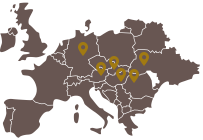About bell casting
The technology of bell casting:
For the bell, like a good recipe for food, take good quality clay and remove all impurities.
The core preparation:
Soak the clay well,
Use a special brick to build the core and binder, which should be well-prepared clay,
Dry it,
Prepare the clay with a well-prepared mortar and a special clay mortar,
Add special clay of sufficient thickness for smoothing.
Dry, then smooth the clay using a template,
Dry and smooth until it is just right,
Finish with special graphite,
Clean the template and choose another plate!
Making the mock bell:
Wear the prepared and treated clay next to the template,
Dry it,
Smooth it in,
Dry,
Smooth it until it is smooth,
Dry,
If suitable, treat with separating fat,
Decorate with text and ornaments as desired by the customer, aesthetically designed,
Look it over well, so there’s no mistake!
Making the cape:
Mix special fine mud and brush on in several layers,
When dry, coat thickly with mud,
Dry it,
Wrap it around a tyre,
Make an inlet for it in the manner of a pouring pour,
Burn it with the pattern
Preparation for pouring:
Disassemble the burnt pattern, remove the mock bell,
Clean up the fitting parts and coat with milk spray,
Carefully assemble the pattern, sealing the expiring parts,
Roll it up with good black earth to the top of the pattern or inlet,
Build up the gutter and lead it to the inlets and dry it out!
Pouring:
Melt the 22% tin bronze,
Slag it well,
Slowly release the metal as the pattern requires,
A well-filled sample will make a friendly mortising sound to indicate that it is full,
Pass the rest of the metal on to the next pattern and slowly release the ore into the mould!
The bell pattern took 5 months to cast, with no more than six minutes for four bells.
Excavation:
Let it rest in the ground for 24 hours,
Dig the bell with the pattern and let it cool to ambient temperature,
If it feels cold to the touch, dismantle it from the inside, then from the outside,
Clean it,
Condition it, it will show the sound you expect from it,
See for yourself and hear it was worth the work!
Make the right lightweight action, put in the right mallet,
Slowly condition it, test it, ring the bell
If the sound is pleasant, feel free to wind it to everyone’s delight!
Sing God’s glory, peace, love and joy in every direction
History of the bell
When Alexander the Great died and his funeral procession was carrying his golden coffin, for some reason, hundreds of bells were hung on the chariot as it made its way.
In Greek and Roman times, bells were also used as badges of dignitaries and to signal important events. Bells were also found around the necks of favourite animals.
The Greeks were a sailing people, and on the idea of Archimedes, when the weather was bad, when the fires on the heights were not visible, reddish skies, torrential rain, etc., they would pull bells on buoys from boats to the entrance of the straits and thus guide the sailors with their sound.
In Roman times, bells were placed around the necks of criminals to attract the attention of the people.
Running with the cane was a similar humiliation at the time, in which the bells played a major role. Anyone who wore a bell then did not live to see the sun set.
Christians were initially persecuted by the Romans, so they still could not actually use bells, because they would have attracted the attention of the persecutors. To avoid this, wooden bells were made to make a sound similar to the woodpecker’s knocking, but with a different rhythm, during secret services in the woods. These so-called wooden bells are still used by the church today, usually in conjunction with a chime on spring festivals and Holy Week.

There is a lovely little church story that the saintly Paulinus, the devout bishop of the city of Nola, was walking in the woods in his sleep and prayed to the Lord for a sign. Then a light came on and flowers, replica watches shaped like bells, rang like bells. According to this tale, he invented the bell, and we know from the history that the story is a nice one, but it does not cover the reality. What is true of the story is that Nola has a lot of bells, courtesy of Bishop St Paulinus.
Small bells were already made in small monasteries, I mention here the monks Bitnus, Essa, Tesach, but the most prominent of these is the Benedictine friar Daggeaus, around 536, who made bells for the churches at the request of Pope Sabinian, about 50-80 Kg. He made all church paraphernalia by casting, e.g.: church shields, shepherd’s crook, baptismal font, etc…
The official use of the bell was decreed by Pope Sabinian in 604. From that time onwards, the bell became a feature of Christian worship. It also has many everyday functions: to tell the time, to announce births and deaths, and to signal danger.
The greatest patron of bells was the German-Roman Emperor Charlemagne. In the meantime, gunpowder had arrived in Europe by the Silk Road, and the white man had to destroy it, so at first the bell founders had to cast the mortars.
In Europe, there were wars of conquest and succession, so the cannon was more popular than the bell. In battles, the losing enemy’s cannons were offered to churches. On other occasions, however, the bells were taken from the towers of churches to be recast as cannon. For centuries, this ‘blessing’ activity went back and forth.
1241-42: the Tatar invasion. They also used bells in the neck of the post-horse. Anyone who came across one was obliged to help the rider on his way if necessary. 1456: Nándorfehérvár. The armies of János Hunyadi and János Kapistrán are victorious over the armies of the Turkish Empire, hence the DARK bell, decreed by Pope Calipstas III in the Christian world.
Kőszeg: In honour of the defence of the town of Keszthely by Nicholas Jurisic, the bell is rung there at 11 o’clock.
1571: The naval war at Le Pantheon, led by Don Juan de Austria, defeats the Ottoman Turkish fleet, and the bell is rung for the christening in honour of this.
During the revolutions of the 1800s, bells again came to the fore as a raw material for cannon casting.In the Great French Revolution, around 100,000 bells were destroyed.
Gábor Áron in Transylvania also came to the aid of the revolution with cannons made from bells. He melted down about 300 bells. The material of the bell was later withdrawn from a strategic role due to: “steel production”
Those listed below have done much to promote the large-scale production of high-quality steel:
I, Benjamin Hastman, master watchmaker. Siemens-Martin blast furnace engineers Bessemer-Thomas Mannesmann with the production of seamless pipes All this around 1860. High-quality steel encouraged the manufacturer to produce pipes with a higher load-bearing capacity. The larger charge made the cannon far more powerful. So the new material worked. Nevertheless, the bells continued to fall victim to the theatre of war. During World Wars I and II, they were thrown out of church steeples.
Some famous bell founders from the past:
- Ferenc Bp.-Kisgejőc
- Pozdrech János Bécsújhely
- Korrench Márk Eger
- Anton Fiel Varasd-Kőszeg
- Seltenhoffer Frigyes és Fiai Sopron- Udvari Harangöntő
- Novotni Antal Temesvár
- Hőnig Frigyes Arad
- Éberhardt Henrik Pest
- Szlezák László Pest
The Gombos family, the successor of the Szlezák company, manufactures its products using traditional, clay-cast technology in the area of őrbottyán, in the county of North Pest. In 1953, during the Rákosi era, the 100-strong factory was closed down for political reasons.
The company was reborn by Lajos Gombos in 1958. In 1985, his son Miklós added a new workshop, technology and products. His son Ferenc wants to continue the same craft.
After this short historical part some big bells:
- Colokol – Moszkva, 4437mázsa / Monterina Mihály
- Kaiserglocke- Köln, 525 mázsa / Hamm A.
- Peking, 1099 mázsa
- Budapest Szent István Bazilika, 77 mázsa / Walczer Ferenc
- Esztergom, 54 mázsa / Szlezák László
- Vác, Roskoványi 43 mázsa / Szlezák László
Currently the largest working swinging bell in the world is in the USA and is owned by the Packard company.






